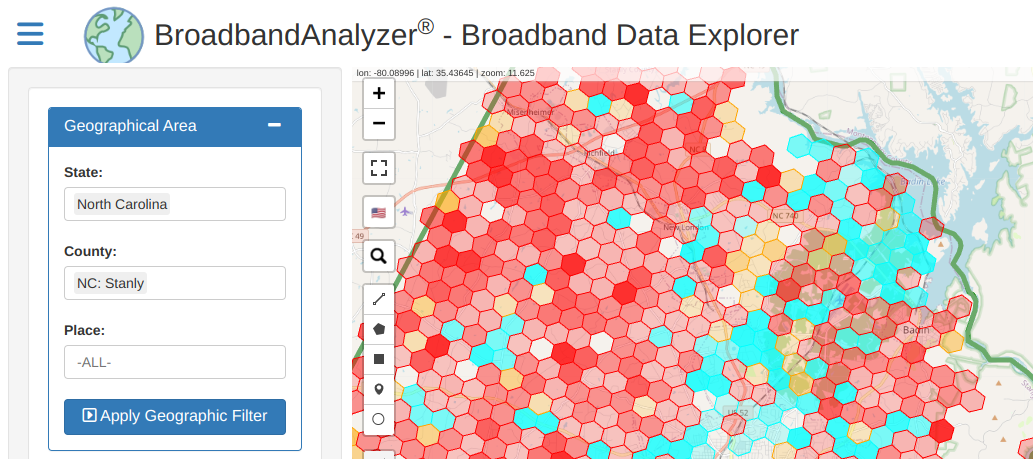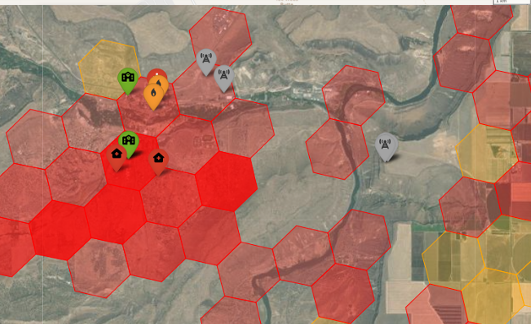BroadbandAnalyzer®


Below are answers to some of the most common questions about Broadband Analyzer. If you need additional information, please do not hesitate to contact us.
BroadbandAnalyzer uses public and private data from a variety of sources that include: FCC BDC, US Census, US Treasury, The Broadband Data Collection and ArcGIS Living Atlas of the World, Measurement Labs, The National Address Database, and many others. BroadbandAnalyzer can also import geospatial data, which facilitates the use of private and third-party data sets. Our reports are available by county or recognized places such as cities and towns. Regional reports that include multiple counties or places are also available. Statewide or multi-state analysis also available.
BroadbandAnalyzer includes census block data, H3 hexagon data at resolution 8, and address data where available. BroadbandAnalyzer also supports the uploading of polygon, multi-polygon, line, multi-line, and point data from Geopackage, ESRI Shapefile, GeoJSON, and Google Earth KML.
Broadband Analyzer analyzes, cross-references, and reports on the same data state and federal agencies use to determine the eligibility of a broadband serviceable location (BSL) for broadband subsidy. The maps and reports within BroadbandAnalyzer are designed with the grant application process in mind by quantifying which locations, hexagons, and census blocks meet the requirements for funding and have not already been awarded state or federal broadband expansion funding. BroadbandAnalyzer also provides the ability to export the filtered and analyzed broadband data that drives the built-in reports in order to allow analysis in external platforms, such as GIS, Google Earth, and Excel.
BroadbandAnalyzer uses public and proprietary data to determine the estimated cost to deploy fiber-to-the-home and fixed-wireless to census blocks and hexagons. Customizable cost limits break census blocks and hexagons into one of three possible cost groups: High-Cost, Commercially Viable, and Practical for Subsidized Fiber Deployment.
BroadbandAnalyzer and the Strategic Networks Group eCheckup provide the ability to map public speed test data but also to collect new speed test data along with the eCheckup. Our customized speed test captures accurate location information from the user as well as information about the user's experience, costs, and budget. Speed tests from the eCheckup also verify the provider and technology type used to perform the speed test.
BroadbandAnalyzer includes nationwide broadband, demographics, and infrastructure for the United States. Our reports are available at the state, county, city, town, and regional levels. We also have similar data for Canada that can be made available upon request. Contact us to find out more.
Broadband Catalysts and Strategic Networks Group have teamed up to create a world-class Digital Transformation Platform: BroadbandAnalyzer, which provides the geospatial analytics engine, broadband availability and demand data. It integrates seamlessly with Strategic Networks Group's Digital Needs and Readiness Assessment and eCheckup technologies. These organizations have worked together over the past 15 years to measure, map, and evaluate broadband availability, utilization and demand in cities, counties, and statewide projects.

After decades of broadband consulting experience that ranges from broadband economics, availability, existing demand, latent demand, potential impacts of local GDP, high-level cost estimates, and network designs, Broadband Catalysts and Strategic Networks Groups teamed up to automate what had previously been time-consuming and costly consulting functions. By eliminating much of the repetitive workload, BroadbandAnalyzer facilitates deeper and more meaningful analysis of the broadband market and how it is impacting both residents and businesses.
BroadbandAnalyzer allows planners to focus more on digital equity, inclusion, and transformation. Our historical data also helps illuminate opportunities within communities to increase the profitability of local farms and businesses, attract new businesses, and retain a better-educated and more qualified workforce.
By providing a more holistic view of broadband economics, digital equity, and community benefit with ongoing data updates, BroadbandAnalyzer can provide Digital Equity as a Service, which provides long-term ongoing and measurable benefits for communities.